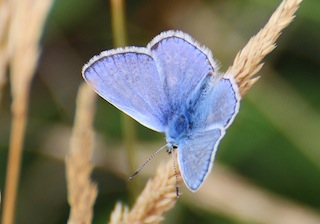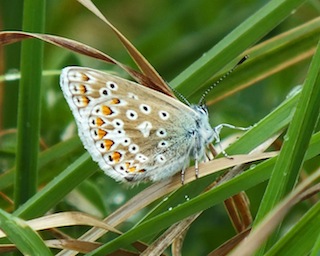 The Common Blue is one of the butterflies counted annually in Butterfly Conservation’s Big Butterfly Count.
The Common Blue is one of the butterflies counted annually in Butterfly Conservation’s Big Butterfly Count.
Photo: Amanda Scott
Scientific name: Polyommatus icarus
Cornish name: ‘Tikki-dui’ is the general word for butterfly
Conservation status: Not considered threatened.
What to look for:
- Colouring: Males and females are very different. Both have a dark border and white fringe to their wings, but the upperside of the males’ wings is blue-violet, while females have brown colouring, with orange spots above the dark border and white fringe, and some blue close to their body. There is however variability between and within populations: in Scotland and west Ireland, for example, the female upperwings are mainly blue. The undersides of the wings of both sexes are paler brown with orange and black spots (see the middle photo below for colouring and pattern of the female wing underside).
- Size: Wingspan of 28 to 36 mm.
- Where: This common butterfly likes sheltered places and occurs in many habitats, including heaths, grassland and sunny woodland glades: it is a garden visitor.
- When: The adults can be seen from May to September. The butterfly produces two broods per year (or often a partial third brood in Cornwall) in southern parts of the UK, and there can therefore be a lull in numbers in July, between broods.
- Similar species: Female Common Blues can be confused with the Brown Argus, especially when the former have a strong brown colouring.
 Common Blues, as the name suggests, are widespread and the most common blue butterfly in Britain, found in most places apart from Shetland and the mountains of Scotland and Wales. It forms colonies of up to a few hundred individuals and can readily colonise new suitable areas.
Common Blues, as the name suggests, are widespread and the most common blue butterfly in Britain, found in most places apart from Shetland and the mountains of Scotland and Wales. It forms colonies of up to a few hundred individuals and can readily colonise new suitable areas.
You are more likely to spot the bright blue males as they patrol their territory. The brown females spend less time on the wing. They can be spotted nectaring or flying close to the ground as they search for the larval foodplants (mainly Common Bird’s-foot Trefoil, and also Black Medick, Lesser Trefoil and White Clover) on which to lay their eggs. When the weather is cooler you might spot both males and females roosting head downwards on grass.
The green caterpillars hatch from the white eggs after a few days, feeding on the underside of the leaves of the foodplant. First brood larvae will pupate and emerge as adults in the same year; later brood larvae overwinter as caterpillars in leaf litter before pupating in the spring.
 Did you know…?
Did you know…?
…Overwintering caterpillars turn olive green, providing good camouflage. In the spring, they revert to a brighter green.
…Blotches on the top of foodplant leaves are a good sign that caterpillars are feeding on the underside: earlier instars do not feed all the way through to the upper surface.
More information and references:
Mansell, E. and Newman, L.H., 1968. The Complete British Butterflies in Colour. Ebury Press and Michael Joseph, London.
Wacher, J., Worth, J. and Spalding, A., 2003. A Cornwall Butterfly Atlas. Pisces Publications, Newbury, Berkshire.
Published: August 2014
Author: Amanda Scott
Photos: Amanda Scott
